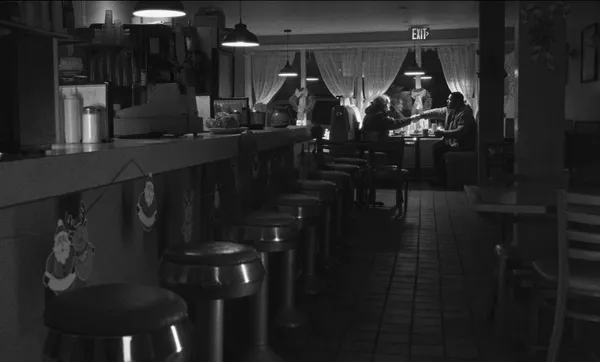Eye For Film >> Movies >> Stationed At Home (2025) Film Review
Stationed At Home
Reviewed by: Jennie Kermode

The first thing that will grab you about Daniel V Masciari’s ode to the oddities of small town US life is the sound design. Despite being “half of a film,” as he points out, it’s an area which many directors leave to the experts, rather than working with those experts to make it a part of their overall concept. Here, sound is storytelling. It’s first thing in the morning, and Ralph (Erik Bjarnar) is just waking up. We don’t see his face directly for a while, but observe little details as we move around his cosy, isolated home, hearing the sound of footsteps, a bubbling cafetiere; the radio says that it’s Christmas Eve and that there are perfect clear skies with the ISS due to fly overhead at 5:47am.
It’s 8am just now. The cat (Lyle Schneider) is still sleepy. It eats lazily, not fearing competition. Ralph assures it that he’ll be back so they can enjoy the big moment together, because this is 1998 and they haven’t had the chance to see a space station before. Outside, his boots crunch beneath him as he brushes freshly-fallen snow off his cab. It’s number 71, which suggests that there are more than are really needed for the quiet little town of Binghampton in upstate New York. Nevertheless, Ralph will find plenty of passengers, and between them they will change his day – and perhaps his whole life – in unexpected ways.
Where cinema has traditionally had its characters look to the stars for inspiration, often with mystical allusions, Stationed At Home invites its viewers to join in a celebration of what humans have achieved, to experience fresh awe at the thought that we put people on the Moon and we built an orbital laboratory where people can live amid the vacuum of space. One character has a daughter who wants to be an astronaut. Another peddles conspiracy theories, but is still plainly fascinated by the subject of space. A third has a secret that will tie it all together. Even the local strip club is called Juicy Mooners. Ralph has an old photograph of his mother with a note scribbled on the back: ‘Always look up.’ The film is shot in black and white, and the brightness of the snow, in contrast with blackness of the night sky, makes it impossible to forget that we’re clinging to the surface of our world within a vast and mysterious universe.
The beautiful cinematography, the bluesy jazz score and the gentle pace of the film are beguiling, but Masciari makes sure that we don’t lose sight of the ridiculous. On television is shop and, later, a café, Santa Claus Conquers The Martians is playing. We are privy to snatches of bizarre conversation, in the cab and in local bars. A scuzzy out-of-towner carries multiple different ID cards. There’s a rumour that he’s a serial killer. Every now and again we cut back to Ralph’s home, where the cat is watching the window and the telescope in the yard, waiting.
It’s the devotion to detail and the absolute sincerity of the performances that really give the film its magic. There’s also a warmth to the characters which more than balances the chill in the air. Early on, when Ralph does a favour for a passenger, a space is created in which more than usual kidness seems possible. The question is, is Ralph willing to open up to the possibilities in his own life, and how far will he go?
Reviewed on: 05 Apr 2025















